
讲座时间:2019年11月20日18:30-20:30
讲座地点:中央美术学院美术馆学术报告厅
讲座嘉宾:李军 中央美术学院人文学院院长、教授、博士生导师
主持人:高高 中央美术学院美术馆馆长助理
高高:今天我们非常荣幸地邀请到中央美术学院人文学院院长李军教授分享他在达·芬奇研究方面一个新的成果,下面请大家欢迎李军老师。

李军:谢谢高高老师的介绍主持。
今年是达·芬奇逝世500周年,全世界各地有一系列的展览、纪念活动和出版。咱们中央美术学院现在正有跟达·芬奇相关的一个展览,也有一系列的专家、学者讲座跟大家分享。
大约在20年前,我就对达·芬奇的作品非常感兴趣。1996年,我去巴黎的时候就对他的作品有一种特别的感受。今年借着达·芬奇逝世500周年和咱们学校展览的机会,把这个老话题重新拿起来,做了一些研究,至于做得好不好要大家来考验。
题目叫“蒙娜丽莎为什么微笑?”大家告诉我她为什么微笑?因为幸福?
蒙娜丽莎她有两个孩子,给她老公乔孔达先生生了两个健康的儿子,而且还怀了第三个,这个很有道理,因为幸福。
牙疼?
牙疼也会笑吗?那就是痛苦。幸福和痛苦,也许是介乎两者之间。
今天我想在两个领域之间、两个关键词之间来讨论这个问题,一定要在我讲座的最后才能揭秘,她为什么微笑。
我可以事先告诉大家她的微笑不是因为幸福,也不是牙疼,而是别的原因。
题目的副标题提到了两个关键词“科学”与“反科学”,但是“反”科学打了引号,不是封建迷信的那种反科学,而是达·芬奇在他的艺术中运用了科学,同时又给科学保留了余地,给了它限制。原因是什么?下面再谈,这个问题好像跟她的微笑没有关系,但是我想说是有关系的。
第一张图:全世界最著名的绘画,保存在卢浮宫里。原来在大画廊意大利绘画的展厅里面,最近需要把这个空间重新装修,把它转移到黎塞留厅去了,跟荷兰小画派的作品放在一起。
今年暑假我去了一趟卢浮宫,被迫排在看《蒙娜丽莎》的队伍里边,因为要进到卢浮宫去,队伍要排半个小时甚至更长。后来我们挣脱去了另外一个展厅,那些要看《蒙娜丽莎》的观众我估计要继续再等半个小时,才能有缘看大概5-10秒钟,然后又被后面的人群给挤走。当然这是一个神话,大家都去看什么,看蒙娜丽莎的微笑,蒙娜丽莎为什么微笑?这是一个谜——是一个世界之谜。
首先我们要了解一下作者达·芬奇。19世纪初,瑞士的历史学家布克哈特在《意大利文艺复兴的文化》这部书里边引用了一个词,这个词不是他发明的,意大利语“Rinascimento....”是“一个普遍的人”,“普遍”来自于“universal”包罗万象什么都在里边。这个词是“普遍”的意思,也是“全能”的意思,在《意大利文艺复兴的文化》里,表达的是一个“全能”人的意思,这是一个世俗的含义,如果有一个宗教含义。宗教中这个词通常用来指“耶稣”,后来布克哈特用这个词形容文艺复兴的一群巨人,达·芬奇是这群人中的一个,而且是比较有代表性的一个人。
早年他在求职的时候,想离开佛罗伦萨,到意大利北部重镇——米兰公国,他向米兰公爵求职的时候写了一封求职信,毛遂自荐。求职信中列举了很多能力:会造炮、造桥,可以制造枪支弹药,可以做战车、要塞等等,也可以设计建筑、做雕塑,绘画也不比任何人差。他对自己的自我评价中,把绘画、雕塑和建筑的能力放在最后。对于一个君主来说,那些涉及到战争、军事、公共交通、安全这些东西更重要,所以达·芬奇最后说他自己绘画不比任何人差。
我们现在看到的是达·芬奇的遗稿,他的笔记的数量惊人。现在能够统计7200多页,但是7200多页只是他所有手稿的1/4,大部分都已经散失了,没有流传下来。
从现有的7200页手稿来看,几乎涵概了当时全部知识和实践的领域,达·芬奇不仅仅是艺术家还是发明家、工程师、科学家、数学家、哲学家……是一位无与伦比的大师,一个传奇,我们可以在这张画里面看他大概是60岁左右的时候画的一张自画像,这是有争论的,因为达·芬奇并没有说这是他自己的肖像。

首先看这张素描:描绘了一个智者,眼睛非常深邃,充满智慧,注视着画面的外面,抿着嘴。这种半身头像,按照古代传统不是君王就是智者形象。这个时间前后,拉斐尔在罗马梵蒂冈签字厅画过《雅典学院》。《雅典学院》里的柏拉图是一位哲学家,柏拉图的形象跟这幅自画像非常像,我们可以看出来他在当时意大利人的心目中长相就是这个样子,是一个智者的形象。那个时候达·芬奇,看上去可能有80岁,正因为这一点,很多学者说这幅画可能不是达·芬奇的自画像。
我们今天确实没有办法完全论定是不是,但是更愿意看成是一个自画像,这是文艺复兴时代全能人的形象,一个智者的形象或者一个哲学家的形象。我们今天要谈四种关系,这四种关系先跟大家说一下,下边一个一个来展开。
这四种关系,表面上看这一对关键词跟蒙娜丽莎的微笑没有关系,我想说它们是紧密相关的:
达·芬奇艺术中的科学;
达·芬奇科学中的艺术;
达·芬奇艺术中的“反科学”;
达·芬奇的艺术与科学一种内在本质的联系。
第一部分:艺术中的科学。
达·芬奇的绘画之所以能够在15世纪末到16世纪初在意大利艺坛脱颖而出,实际跟他的科学研究是有内在关系的。
现在看到两个肖像:15世纪末达·芬奇画的。《蒙娜丽莎》是16世纪初达·芬奇晚年画的。
第一张肖像:《美丽的费罗尼耶》,描绘的是一位16、17岁的少女,这个少女已经成为了当时达·芬奇的恩主,米兰公爵费德里科公爵的情妇。这张画有什么特点呢?大家知道文艺复兴时期,在达·芬奇之前女性肖像更多是被展示为侧面像。侧面像可以对脸部轮廓有一个全面的展示,大家可以联想起古代钱币上的形象,是一个纪念性的,会显得比较规整,尤其对女性来说会显得比较贤淑、比较温顺,一目了然的感觉。

La belle ferronnière,1490-1496
这件作品细节刻画非常细腻,达·芬奇改变了传统侧面像的做法,好像侧面的女性第一次听到了召唤,把脸从侧面转到了3/4的侧面。尤其是眼神,可以看到她看着画面外的观众,不一定是直视也许是斜视。达·芬奇早期的绘画中,头发、首饰和服饰的描绘相对比较细腻,到了后期这些都简化了。这张画给我们最深的印象,好像是费罗尼耶听到了什么响声突然把她的头转过来,冷冷地看着画面外的观众,当然首先是看着画家。
我们可以看到这个光是从左侧面来的,头发上有高光,尤其是这一块在她的脸颊阴影里边透着一片亮,看原作会非常清楚,是费罗尼耶穿着的红色裙子的反光。这在那个时代佛罗伦萨的绘画里是绝无仅有的,表达的是一个瞬间的动态,捕捉到这样一个女性似乎是一个主体、是一个灵魂,她回过头来从一个被观看的角度转过来,冷冷地斜视了画内外的观众,那一个瞬间光的光影留在了她的脸颊上面。

Mona Lisa,1503-1517
《蒙娜丽莎》也是一样,他延续了这样一种捕捉动态的方式,在瓦萨里的《艺苑名人传/大艺术家传》提到达芬奇的时候讲了一个关于蒙娜丽莎的故事。
瓦萨里提到她(蒙娜丽莎)是一位很幸福的女人,一位富商的妻子,生了两个孩子。她的丈夫为了犒劳他的夫人要给她画一张肖像,这也是当时佛罗伦萨的一个传统,请的是当时很有名望的画家达·芬奇。
瓦萨里说蒙娜丽莎很忧郁,不开心。怎么办呢?为了让她显得很幸福,据说达·芬奇雇了一支乐队在旁边奏乐,还雇了两个小丑在蒙娜丽莎面前杂耍,小丑的一个动作吸引了蒙娜丽莎,让她忍俊不禁,正在将笑未笑的时候被达·芬奇捕捉下来了。这就是蒙娜丽莎微笑的由来,这是瓦萨里的说法。

我们可以看到她也是这么一个动作,这两个人的姿态是差不多的,只不过她把手交叉在一起,前面有一个栏杆——实际上是一个椅子的椅背。两幅唯一的差别在于,蒙娜丽莎背后有一个建筑栏杆,好像是在梁廊上面,梁廊外面是一片托斯卡纳的风景。实际上她有一点微笑,有那么一点影子,这样一个瞬间的把握,我们可以概括为“最具有包蕴性的瞬间”,这是18世纪的词,但是可以用它来概括那个时期达·芬奇绘画的一个特色。
他其实有很多的科学观察,也就是说刚才这样一种动态瞬间的把握,来自于达·芬奇那个时期对于自然的观察,这就是他的科学。
他说:“在河流中你碰到的水,是去水的尾巴,又是来水的头……”每个人有这样把手伸到河水里面的经验,他说的是自然中的真实情况,过去和现在,或者说来和去是川流不息的。二者之间是一个动态的联系。
这一段观察他想回到哲学的命题——芝诺(Zeno'sparadox)的悖论。芝诺是一位古希腊哲学家,他提出了很多悖论。其中有一个悖论叫做“飞似不动”:一只在空中飞行的箭,是不动的。怎么会不动呢?芝诺说:“我们想象一下吧,箭运动的轨迹是一条线,它一定到达了线上的某一个点,在一瞬间肯定是不动的。然后又到了下一个点、下一个点....这么说箭在每个点都是静止的,怎么会变成运动呢?它应该是不动的,这就是芝诺悖论。”针对这个达·芬奇说:“过去和现在、来和去、此和彼是紧密相连的。”对于前面一个瞬间是尾巴,对另一个瞬间是开始。“每个当下亦复如此。观察光线的时候眨一下眼再看你的所见已非刚才所见,刚才的所见已不复存在...”可以看到他平时随时揣一个笔记本在兜里边,当时很多艺术家都是这样,看到什么好看的图像和形象可以勾勒出来,看到一个有意思的现象记录下来,这是一个习惯。
对于最具包蕴性瞬间的观察得益于此,因为他有这样的观察所以绘画中的特征只有他才有,他同时代的画家并没有这样的东西。这是达·芬奇艺术魅力的一个重要方面。

这是他画在一个胡桃木上的木板油画。这幅油画没有完成,大家可以看到他喜欢使用侧面、左边射过来的光照在这位女郎的额头、鼻梁、脸颊上,而眼窝里边的眼睛、鼻翼下、嘴唇……陷入阴影之中。这里边可以看到旁边的线条都非常概括、很平面。
女郎似乎正从某一个状态里面脱颖而出,从一个帷幔里边突然露出了脸,或者是游泳的时候把脸忽然露出来那样一种瞬间的感觉。这种感觉来源于他绘画中的一种特殊技法——烟雾透视,好像是“烟雾散开之后看到了一张脸”。
文艺复兴时期尤其是佛罗伦萨的绘画特征是古典主义的一条边际线。中央美术学院的靳尚谊先生在80年代特别强调古典主义,回到古典主义是纯化语言的一个阶段、一个过程,他特别强调那是一条把人和物、环境区别出来的古典主义的边际线。这条线是佛罗伦萨艺术的特征,但不是达·芬奇的特征,达·芬奇不是这样。
达·芬奇的边际线是被旁边那些阴影生涩的线条衬托出来的,不是画出来的,这实际上也是他的一个观察——“烟雾透视法”,或者叫做“空气透视法”。

为了能够更好的分析,我们可以看一下《蒙娜丽莎》背后风景的处理。空气不是透明的,是有质感的,是物质,所以会参与在视觉形象的塑造里边。我们大家知道阿尔伯蒂“焦点透视法”是物体的近大远小,达·芬奇认为那是不够的。物体在近和远的时候还有一个清晰和模糊的差别,这种清晰和模糊之所以会产生就是因为有空气的存在。

远景跟天际线融为一体了,我们做一个简单的分析:背后的风景第一层可以看到从梁廊上俯瞰的托斯卡纳的一个风景(俯瞰);这里面有蛇形的道路,赭石的山还有一点土红的土地,跟自然存在是相应的。另一面可以看到有人类文明的产物——桥梁,更近的地方色彩要更加深一点、远一点就开始泛白了,这个俯瞰是比较真实的。

第二层这里有一条水平线——一个湖。这个地方景色山和水开始变得模糊了,开始加进了一点蓝的调子。好像是一个平湖在他身后变成一个浅滩,水在流动,相对于第一层变得模糊了。我们可以看到空气氤氲弥漫的效果。

第三层,远山更加模糊,形体消散在空气和天空中。我们可以看到他的作品中很多风景都是这样的,这当然是得益于他的观察,空气透视法是科学,因为空气是有质感的,阻挡了视线,导致近清晰、远模糊。
从《蒙娜丽莎》的微笑可以看到刚才的特点——没有一条明显的边际线。

今天实验科学家已经做了这样的实验,对《蒙娜丽莎》做了很多科学观察,发现《蒙娜丽莎》覆盖了很多色层,每一个色层都非常薄,大概只有0.25-0.5毫米厚,非常薄、半透明的,用油调的颜料。一层层罩染,每一层根据调色油的差别,干燥时间的不同——有的需要几天,有的可能需要几个月,现在能够科学检测到大概有20-30层的图层在上面,达到那样一种含蓄、氤氲、边际的模糊。
达·芬奇愿意用他的左手——他是一个左撇子,去把形晕散一些。这样的画面特别耐看,也是很难的,需要很长时间。《蒙娜丽莎》从1503年画到了1517年,大概用了十四年时间。我们可以从那个时期他的手稿里边看到他在研究什么:研究嘶喊、喊叫、嘶叫,马在嘶叫、人在嘶叫。

侧面像:一张喊叫的嘴。旁边画了很多的观察,这个图的左上角真的画出一张嘴,达·芬奇表示要导致这样一个微笑,要有十几块肌肉协同的运动才能这样,这是建立在解剖基础之上,他研究十几块肌肉怎样共同工作从而导致嘴角微微的微笑。这个研究的时间是16世纪初期,和《蒙娜丽莎》同一个时期,他的微笑是以这样的科学观察为依据的。
这是我谈的“艺术中的科学”,达·芬奇艺术魅力的一个重要方面在于他对于自然的观察和科学记录、研究有过人的投入。
第二部分:科学中的艺术。
因为达·芬奇是一位艺术家、画家,他在做科学实验和技术发明的时候,跟一般的发明家不一样,一般发明家需要找一个木匠做一个模型,或者找一个画家帮他画出来。但达·芬奇想到了、观察到了之后,他就能够画下来,变成形象,我们可以看到这些很残酷的武器,四个大镰刀,一个骑士骑在中间,前后都是大镰刀。

这是一个危险的战车,是达·芬奇设计的武器。下面还有两个达芬奇设计的早期装甲车的雏形,能够机械运作,里面还可以对外放枪。


这些我们所谓的直升机、飞行器、降落伞都是他的奇思妙想,他的发明之一。

关于解剖学,这是达·芬奇把骷髅从中间切成两半,有一半在切的过程中碎了。这本来是做科学实验观察的记录,目的是尽量表达好这个结构,可能达·芬在画的时候就画成了两半,一半是残破的另一半是相对完整的,连接起来能看出整个结构是怎样的,这是一位艺术家的科学研究。

这是他画了一个人脑腔的形状,他想知道脑腔是什么样的,但是那个时候没有那么好的手术刀,很可能会因此导致碎裂破损。达芬奇找到一个头骨,在头骨上开了三个小洞,把空气和血水放出来,形成一个实体的腔室,他采取了青铜器铸造的施蜡法——把蜡熔化了,在三个孔洞里把熔化的蜡浇灌进去,等冷却了,把头骨打开。就得到一个完整的脑腔室结构,这一点需要借助于他的艺术经验做到,没有这一部分我估计他的科学观察、科学研究也没有那么出色,这是一个很明显的例子。
下面是一些文献:给大家简单看一下,达·芬奇解剖了很多很多尸体。要是没有绘画技巧,还是不能让人满意,你要懂得几何学等等,比如文字都在这儿,没有列英文,这是一样的文字。
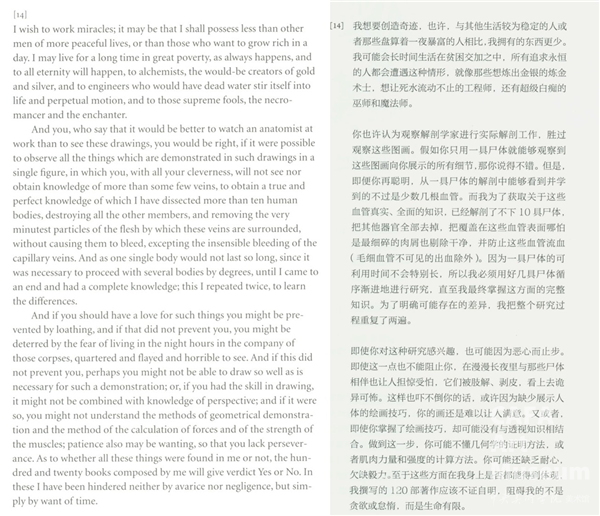
科学中的艺术,大家很容易理解,艺术和科学是相得益彰、互补的关系。艺术的能力和艺术的技能帮助达·芬奇做了很多科学研究。
第三部分:艺术中的“反”科学。“反”打了引号,科学确实给艺术带来了很大的益处,但是我们不能够仅仅按照科学来理解、评价达·芬奇的艺术,只有这一点是不够的。下面会谈艺术中的“反科学”!


《最后的晚餐》是达·芬奇于1495年到1498年间在米兰感恩圣母玛丽亚修道院餐厅里画的壁画。因为当时技法的问题,画完之后不久,颜料就开始脱落了,导致现在十分斑驳的境况。我们可以发现空间里边有很多很奇怪的地方——根据焦点透视法,可以看到屋顶箱板空间跟透视空间是整个内部空间的边际线。
透视线画出来之后发现这个空间不在透视的关系里边,是拼起来的。也就是说,耶稣和他的门徒根本不在屋里,假如看一个透视的分析,我们把里边短粗的线连接起来,大家都知道是集中在耶稣的头上,大家可以看出来,如果是在室内应该很小才对,怎么会那么大呢?因为他在远处,在一个灭点上,但是他没在远处,这一点很奇怪。

下面看圣马太,可以清晰地看到他的衣摆,衣摆后面是一个挂毯,墙面的外面圣马太坐落的位置甚至在里面添加了空间的外面,这是怎么回事?他们这个桌子没有在这个空间里,没有在加出来的空间里边,这又是一个很奇怪的地方。从15世纪布鲁内莱斯基最早发明焦点透视法,到阿尔伯蒂变成理论的表述,焦点透视法在15世纪上半叶到中叶已经非常流行。那时候并不是所有的画家都亦步亦趋地去学习、去追随、不敢越雷池半步。我们可以很明显地发现,这个空间里边的人物形象都比真实的人物的形象要高大,而且处在一个高处,空间在哪儿呢?他们不在室内的空间里,也不在室外,而是在一个高台上边。
在那个时期,达·芬奇的恩主费德里科公爵爱好很多东西,达·芬奇作为公爵宠爱的艺术家,要根据公爵的需求做出各种各样的工作。其中,达·芬奇做了很多舞台设计和布景,达·芬奇把舞台的经验放在这幅画的空间设计上。可以看到餐桌和人物是在一个舞台上,背景是室内的空间,而舞台不在室内的空间里边。

这个空间是一个舞台的空间,是一个永恒的、神圣的、戏剧性的空间。达·芬奇必须要满足宗教的用意,我们看到透视法在一定程度上是被限制的,并没有完全按照透视法来做。

1472年-1475年是达·芬奇艺术生涯的开端。这是他最早期独立完成的一幅油画,在他20岁-25岁这个时期画的。这幅画现存于乌菲齐美术馆,表面看起来很美好,但也有很多奇怪的地方。
先看右半边,圣母玛丽亚所在的那个空间,背后有一块大理石石板,这个石板的透视是变形的、短缩的、水平的,插到建筑结构里边去了,这显然应该是一个错误。

第二个有一个读书的台,下面是一个大理石的架子,上面有一块木板,放着一本书,圣母背靠墙,她的手并没有往前伸出来,而是直直地伸出去的。可是我们看见这个台子是在前景,这样的一个空间是绝对不能成立的。

当然有很多艺术史家都说达芬奇还年轻,那个时候操练焦点透视还不太娴熟。但是我会告诉大家他非常熟练地操练了焦点透视,看一下背后的空间:这个画里面所有短粗的线连接起来,完全能集中汇聚到远山这个点上。《天使报喜》题材,大家都知道故事,大天使加百列突然之间到了一位少女的闺房,少女的名字就叫玛丽亚,加百列告诉玛丽亚说他是天使,带来了一个信息——“上帝要成就在她的身上,她要怀上上帝的孩子。”
15世纪传统的处理法都会画出天上有一个白胡子老爷爷是圣父;还会画出空中有一只飞下来的鸽子,方向是朝下的,往下的。然后就是圣母玛丽亚,把这三个联系起来,那就是道成肉身,圣父、圣灵、肚子里的圣子,这一瞬间就完成了。但是在这个画里面没有,能看到痕迹,这里面在加百列天使翅膀上方的空中有一团金色的云彩,但没有圣灵。

如果我们把金色的云彩和这个灭点连接起来的时候会看到什么呢?这条连线正好指向了圣母玛丽亚的子宫、下腹部。他用这样一个方式表达宗教题材的道成肉身。虽然他没有画出圣父、也没有画出圣灵,但是意图很明显还是有的。

当加百列看到圣母的时候,达·芬奇自己是看着这座山,山作为灭点,否则他的灭点画不出来,这座山有什么奥秘?

山的云雾缭绕是在这儿,好像形成了一个金字塔的形状,前面还有一个近山,可以看到这个山的形状是一个金字塔,跟圣母玛丽亚的形状是不是完全一样。
还有一点,达·芬奇的艺术史研究专家们说,达·芬奇这个时候还画了一个很奇怪的东西——圣母有三条腿。这是什么?是不是椅背还不知道。可以看到远处的山是一个母性的形象,跟下面的圣母形状如出一辙,甚至于连腿这一部分都是一样的。

再看另外一个例子,画家弗朗西斯科·费拉拉作于1470-1472年的《天使报喜》,和达·芬奇的年代相连。
费拉拉在佛罗伦萨东北方向不足100公里,这是现存于德累斯敦美术馆的《天使报喜》。
达芬奇画里面那些奇怪的东西不是一个孤例,这个画里也有很多奇怪的地方:柱子底部似乎于前景中间,往上看柱子顶部却贴了后墙,很奇怪,这个柱子显然不可能这么立着;还有一个蜗牛大家看到这个故事是达尼尔·阿拉斯讲的,很有意思的一个故事。这有一只蜗牛,很大一只蜗牛,阿拉斯问一个很朴素的问题“蜗牛在哪儿?如果是在画面内部,参与了天使报喜的这个过程,它该有多大呢?这只蜗牛加上触角和它的尾巴大概达到成年男子鞋的2/3。”如果以成年男子的鞋42码为例,这个蜗牛就是一个怪兽了,没有那么大的蜗牛,所以阿拉斯说这个蜗牛可能不在画面内部,它没有参与这个过程。它在画框上边,如果它在画框上面就是在画面外的世界,即观众所在的世界。

对于15世纪的观众,蜗牛就在15世纪观众的世界;对于今天的人就是在今天21世纪的观众世界里边,在德累斯敦美术馆真实的空间里边。

这个工作阿拉斯没有做,这是我做的工作:圣父和圣灵连接,这里面有一个鸽子,这两个连起来,道成肉身到哪儿去了?正好是圣母的子宫——她的下腹部,这样一种关系的处理和达·芬奇的处理完全一样。还有一个问题,柱子位于天使和圣母之间,天使按说是看不到圣母的,但是图像里是看到的,这也是很奇怪的一个地方。

第三,假如把蜗牛和圣父连接起来,可以看到,圣父的形状和蜗牛的形状非常相似。所以阿拉斯说这可能是一个圣父的形象,到了我们所在的那个世界,这个故事,我们讲到这儿的时候,我们就会发现这个故事和达·芬奇的故事是有联系的,达·芬奇的做法不是一个孤例。他们的目的是要为一个领域保留一个余地、保留一个场所,这个领域是“奇迹的领域”,因为毕竟是宗教画。什么是奇迹?一个处女可以怀孕,上帝可以进入到她的肚子里去,而且还没有任何接触,他们为此发明一种神学——无垢受胎。这个理论借鉴了当时的光学——一个瓶子里边里面放满了水,假如有一束光照过来,肯定能照到杯子的水里边去,杯壁不能阻挡。无垢受胎就是这样,上帝要进入到圣母的腹中就像光进入水中不会破坏杯子一样,这是奇迹。当然这个事情今天想起来是非科学、反科学。这种做法是“反科学”的作弊,为的是要为那个宗教世界保留一些余地。
达·芬奇也是这么做的,但是我个人认为达·芬奇的那张画宗教意味没有那么强,因为他没有真的画出圣父和圣灵,这需要结合他的个人经验来考察。
第四个部分:科学和艺术的关系
达·芬奇艺术中内在的联系,我叫做科学和艺术的“同体”。

维特鲁威是一个古罗马的建筑师,他著有《建筑十书》,在文艺复兴的时候被重新发现了,被大家研究。达·芬奇自己藏有维特鲁威的《建筑十书》,因为写了很多注释,大家经常会认为维特鲁威是一个文艺复兴时期的人,实际上达芬奇想用这个人表达的是一个古代的观念。
人体、宇宙和几何之间是一个内在的关系,可以用一个人身体的比例来表达方和圆,也就是表达一个大宇宙和小宇宙相似、相同结构的关系。

达·芬奇做了一个人体的解剖,这是一个女性人体,他在里边画出了女体骨骼、肌肉、血管、子宫、生殖器官、血管,旁边写了那么多文字,写的什么呢?

刚才说的维特鲁威人代表的小宇宙和大宇宙相似、相同的一种结构,古人把人称作小世界,如果说人是由土、水、气和火构成的,地球的构成同样如此。人的身体内有骨头作为肉的支撑和框架,同样世界有岩石支撑泥土,人的心脏有一团血液,随着肺部的呼吸而膨胀或收缩,同样地球拥有海洋,随着世界的呼吸每隔6个小时潮涨潮落,人体内的那潭血液生发出无数的血管,遍布身体各个部位,海洋的水也分成了无数的支流,遍及地球各处。人是一个小世界、宇宙是一个大世界,但人的小世界是一个母体,是一个女性的身体,大世界自然是一个更大的母亲,是一个宇宙的母亲。自然就是母亲,所以跟人体的结构是一样的。这样一种关系,小宇宙和大宇宙的对应在中国文化中叫做天人合一,中医理论中有小周天、大周天、阴阳五行这套理论来解释疾病、健康等等。实际上这不是一个东方所特有的,西方也有,达·芬奇时代尤其这样。

可以看到这张解剖图,解剖的是男性人体,画面中还包括视觉神经质等,这不是很科学。他画了一个人脑部的剖面图,旁边画了洋葱的剖面图。达芬奇认为人的头发、皮层、骨骼一层一层的关系,跟洋葱是一样的。人体和植物,动物和植物也是一样的,也是相似的关系。

还有一个例子更加能够说明问题,这是子宫里面的一个胎儿,达·芬奇在旁边又画了一个子宫,一个小孩子,蜷缩在子宫里。他在旁边画了一个坚果,坚果还有一个蒂,瓜熟蒂落,人体的生殖跟植物成熟的规律是一样的,这又是大小宇宙呼应的关系。

另一种呼应是在他的画面里边,我们已经做了分析,山-金字塔式的远山和女性形象、和母亲那样一个内在的联系。我们可以看到这种金字塔形的山一次又一次出现在达·芬奇的绘画中,尤其是出现在画圣母子的画面中。我们可以看到很多这样的例子,会在背后画上那样一个三角形的或者是金字塔形的远山,有时候远山还有另一层远山。
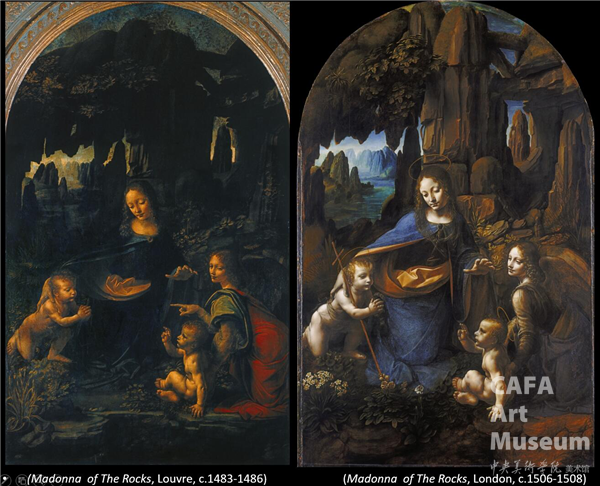
我们以这种角度反观达·芬奇作品的时候,发现他画的两个版本的《岩间圣母》,一是卢浮宫,一个是伦敦国家画廊。似乎是在一个岩洞里面,远处又是这样一种嶙峋的远山,山是一个金字塔的形状,岩洞是一个空洞,如同他所解剖、所画过的宇宙、自然母亲就像一个子宫一样。
岩洞又是一个意象,不断出现在达·芬奇的笔记里边,他小时候在托斯卡纳的山区里边玩儿,看到一个岩洞很幽深,他很害怕,但是他感觉到那个岩洞有莫名的吸引力,他鼓足勇气进到那个洞里,慢慢适应光线,发现一个从来没有见过的世界——他看到了古代的化石、贝壳,还发现了鲸鱼的化石。
岩洞通向宇宙的深处、通向宇宙的奥秘、通向远古,这是他在笔记里非常清晰地表现出来的。这样一个既幽深又诱人的意象在他的绘画里表现出来,比如岩间圣母,从来没有其他画家把圣母子画在岩洞里,这是他个人经验的投射。达·芬奇的个人经验是从人的世界慢慢进入到自然的世界,从现在的世界慢慢过度到远古的世界。这样一个幽深的洞穴又是一个自然的、母性的象征,通过这样一种母性自然的象征回溯到两个根源:一个是寻找母亲,另一个是寻找宇宙的奥秘。宇宙的奥秘确实向他呈现了经验,比如他见到了化石。这样一种经验可以看到这里面同样还有他的科学观察,一层一层的沉积岩,这些岩石是火山爆发后形成的,远山可以看到轮廓,跟空气、天空融为一体。这些东西仍然符合他科学的观察,但是他的科学观察并不是为了观察而观察,而是要引向了他心灵深处,他内在的诉求。


蒙娜丽莎为什么微笑?首先我想不应该把《蒙娜丽莎》当作一张单独的画来处理,我把同时期的一张画——大概1503年到1517年的一张画,这两张还有其他的几张画是达芬奇从来不舍得给顾客的画;这是一个修道院定制的宗教画,画的是圣安妮和圣母子。
圣安妮是圣母的母亲,是耶稣的祖母,这两张画背后都有这个山,在表现一个母性的主题。
这两张画好像没有什么关系,一张是世俗画,一张是宗教画。我二十多年前第一次去卢浮宫的时候就被这张画所吸引,两张画挂得不是很远,但这张画没人看,我被这张画吸引,圣安妮非常年轻,不像是玛丽亚的母亲,甚至于比玛丽亚还年轻。圣安妮神秘的微笑,跟蒙娜丽莎很像,但是圣安妮并没有看到画面外的观众,她看了谁呢。
下面给大家看一下这张画的草稿,素描的稿子有很多构图,最终采取的是这个构图。


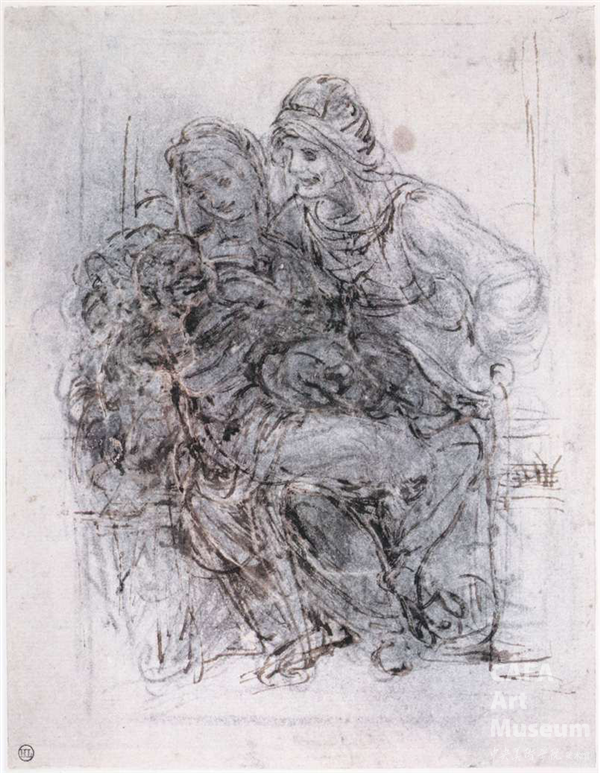
在这个构图里边,圣安妮和圣母是坐在一起的,虽然圣母坐在安妮的腿上(是一条腿坐在他的腿上),基本上算是前后平行的关系,圣子祝福的姿态和岩间圣母相似,这个构图更加整体、更加清晰。圣母坐在安妮的腿上,安妮在背后,施洗约翰在这儿没有出现,耶稣抱着一个羊羔。

圣安妮有两个形象,一张面孔是年轻的,一张面孔是苍老的。老妇的形象是常态,在达·芬奇之前画的题材非常清晰地表现了这样一种关系,他用年龄来表现两代人。上面这幅画作是佛罗伦萨画家格佐力创作的。

而在玛索里诺和马萨乔的一张画,安妮好像坐在圣母的背后,她是一个老太太。
达·芬奇改变了这样一个做法,没有人这么做过,他一定有他的用意,有他个人的秘密。


这张画是萨莱画的,圣安妮又变成了老太太,连他都不能接受圣安妮是年轻的,比圣母还年轻的形象,这是一个传统惯例,这幅画中也画出了一些远山,但是山画的边界非常清晰和硬朗,不是达·芬奇的手法。

达·芬奇自己也画过类似的东西,他画过一个年轻的男人和一个年老的男人共享一个身体。年轻的男人就是萨莱的形象,一个金发帅哥。这个画的作者,他自己是一个老年,画里描写的是欢乐和悲伤,就像一个老人和一个年轻人一样,欢乐永远有另一面,背后永远有丑陋是这个意思。

也许圣母和圣安妮是一个人,艺术史家阿拉斯说她们就像一个人一样,一共有三条腿,她们共享,构成像鼎一样,三足鼎立。姑妄听之,当作一说而已。但是他的观察还是有价值的。
母亲的背后又展开远古的郁郁葱葱的远山,母亲和自然是连带关系,有一种崇高的、宇宙的含义。达·芬奇的科学观为了表达一个动态,选择了一个瞬间——耶稣和没羊羔玩耍。上帝的羔羊,是耶稣的象征,羔羊是要被宰掉的,暗示着耶稣长大后会被牺牲。圣母本来坐在安妮的腿上,但她似乎意识到了未来的命运,有一种悲哀从心里涌出来。她从母亲安妮的腿上欠起身来想去拥抱无辜的孩子,孩子还在浑然不觉地跟羊羔玩耍,当圣母要抱他的时候,他才把头转过来看到母亲。这个时候,安妮看着玛丽亚,看着耶稣,看着羔羊,这已经超越了宗教含义,变成了哲学的含义:这个孩子是宇宙的孩子,这样的牺牲就是宇宙的牺牲。从这个角度再看安妮,可以看到后面的远山一层又一层,但是奇怪的是,你看到上面是头发的一块布,跟后面的远山正好在同一水平线上,你看她的发髻线正好跟一个近点的山在同一条线上。我想说这也许是无意识的,就是画的时候,他在画的时候是同一个位置上,后面的远山更高,当然也是更远,似乎跟前山和跟近景会有一种俯视的关系。这种俯视的关系就是安妮和圣母、耶稣、羔羊的一个关系,是人和宇宙的内在联系,宇宙同时也在看着孩子的牺牲,所以我想说这是一种哲学的含义,不是宗教的含义。

这张施洗的约翰是萨莱的形象,在达·芬奇的绘画里边经常出现。我们在讨论达·芬奇的时候要关注一个词是“之间”:“此”与“彼”的边界是模糊的,它的存在在于“之间”;“形”与“物”我们已经谈论过了;可以看到萨莱是被女性化了的,还有一张男性版的《蒙娜丽莎》——应该不是达·芬奇画的——光着上身,那个也是萨莱的形象。
“老”与“少”,可以看到安妮祖母甚至比她的女儿还年轻,他打破了这个边界;“科学(真)”与“艺术(美)”,科学的研究和艺术的创作是变成了同一个东西;“画面”与“宇宙”,我们可以看到画面对达·芬奇来说就是宇宙,他在作画的过程中实际上跟他写那些笔记是一样的,是在研究自然,当然这个自然不是冷冰冰的,不是没有情感的,或者仅仅是一个理性的东西,而是温暖的,而是能够呼应、回应他的。
再看《蒙娜丽莎》的时候,我们会用另外一种眼光来看:看一些也许我们以前没有看到的细节。
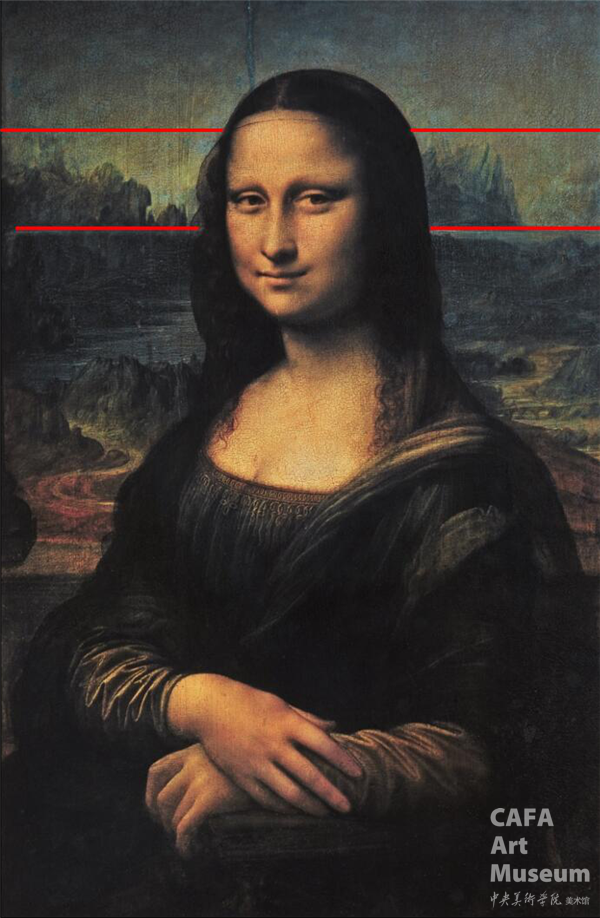
第三层有一个平湖,平湖意味着我们的视线是跟他是平行的,我们是贴着湖的水平线在看,这是说明在这个画里面有一个平视的视线。我们可以画两条线,这两条线之间正好是背后的两座远山,这两座远山是用正投影的方式画出来,这跟其它山、道路、桥梁是不一样的,那是腑瞰的角度,而这是平视的角度,就像我们看《蒙娜丽莎》一样是一个平视的角度。如果我们有了这样的分析之后就会发现这个远山正好是《蒙娜丽莎》眼睛的位置,所以当我们看着蒙娜丽莎的时候,蒙娜丽莎也看我们。与此同时当我们看着远山,跟它对视的时候远山也看着我们,也在凝视着我们。所以自然是有生命的,不仅仅是我们看着它,它也看着我们,这个时候自然是谁,就是我们眼前的《蒙娜丽莎》。
现在讲讲达芬奇的背景:达·芬奇是一个私生子,出生在距离佛罗伦萨十几公里山区里的芬奇村,达·芬奇的家族是公证人家族,属于比较富有的资产阶级。
达·芬奇的父亲返乡回到自己家族小村庄时,跟一位女性有染。那个女性家族是很贫困的一个家族,地位比较低贱,后来这个女孩子就怀孕了。根据当时意大利的习俗,如果生出来是个男孩家族会接受这个孩子,如果是女孩就不能接受。发生这件事情的时候达·芬奇的父亲没有结婚,达·芬奇是他的长子,5岁的时候被带离了芬奇村,住在了达·芬奇祖母的家里。在达芬奇的生活中母亲的角色是缺失的,一直到长大都没有跟母亲在一起,这是由当时的社会地位和社会习俗所决定的。达·芬奇是一位同性恋者,他喜欢男人,他创作的女性形象没有一个是妩媚的,没有一个是从成年男性的立场来描绘的,大多是充满母性的形象,即使画很年轻的女性也是这样。女性很温柔或者冷冷的,或者是带有敌意的,肯定不是一个可爱的、温顺的、听从男人意志的形象。这一点跟达·芬奇的生活经历紧密相关,同性恋的形成是性别认同的错乱,这跟他的家庭有一定关系。
《蒙娜丽莎》画了十三年,一直没有交给雇主,十三年间他不断画这幅画,可以想象,他画的早已经不是那位乔孔达夫人了。
达·芬奇不断研究自然、做笔记,现存的有7000多页,如果完整笔记是4倍的话就将近3万页,跟专家、学者、艺术家出版论文、办展览不一样,达·芬奇不把画拿出去,一直自己留着,他研究的那些科学也是自己私下不断地一本本地写。他所做的完全是一个没有功利的事业,是一个不正常的事情,这个事情需要有一个理由来解释,一定有一个内在心理的需求。通过刚才的讨论和研究,我们说自然不是冷冰冰的,自然是一个母亲的形象,这几个叠在一块能解释他的疯魔,就是他一直在寻找的能够平复他自己心理需求的东西,这个东西是什么呢?
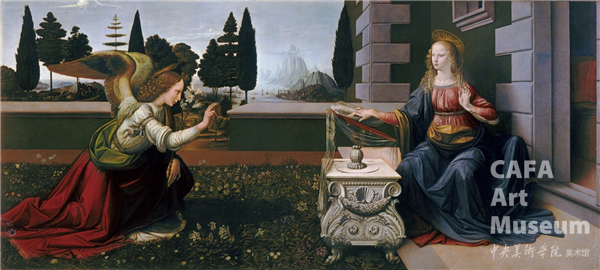
回到这儿看,这里有一座山,透视的灭点,当这位少年天使看着圣母的时候,圣母并没有看着他,在画面外达·芬奇看着画面内同一个角度的远山,母亲回应了吗?母亲没有回应,他们没有形成交流。
最后是“子”和“母”的关系:

达·芬奇这幅画里,我们看到的是这位母亲的回应,旁边的圣安妮和圣母子已经从另一个侧面解答了这个问题,安妮和玛丽亚都在看着小耶稣和那只羔羊,这两张画是同时期的,都是他舍不得离开他自己身边的,这张画与《蒙娜丽莎》一定程度是可以互补的,旁边那张画里面安妮和母亲看着那个耶稣和羔羊,背后那些远山似乎层层退远。但是在《蒙娜丽莎》里面,《蒙娜丽莎》是看着画面外的观众,背后的远山也看着画面外的观众,我就想起李白《独坐敬亭山》中的两句:“相看两不厌,惟有敬亭山。”我想这就是诗人的直觉,一下就穿透了,我们看到山,山也在看着我们,如果感觉到被慰藉的时候,山就是自然,也可以是一个人格,相看两不厌。我想说只有这样一个角度才能解释达·芬奇的秘密。
蒙娜丽莎为什么微笑呢?因为她看到了她的孩子,尽管这个孩子是一位60多岁的老头,谢谢大家。
高高:感谢李军教授精彩的演讲,让我们在从来不曾注意的细节中层层推远。我想很多观众跟我一样都还沉浸在李军老师层层的线索里边,不知道今天的观众对此有什么问题或者是另外的想法?
提问一:李老师今天讲得非常感人,层层的推理,对于做研究、做学问非常重要,我看过林风眠小时候的经历,我非常感动,他好像是童年母爱缺失。跟你讲的达·芬奇有点儿相同之处。林风眠的母亲在一个染坊里染布,和一个年轻的染织工有点儿情感上的瓜葛,最后导致了被家族赶走的故事,林风眠始终在画那种画。达·芬奇是不是也有恋母情结在里边,当然他还加上一些宗教的意象,看了你的研究,他的笔记具体是什么样的我没有看过,里边是不是有一些人与自然的关系,有他的认识。
李军:他有很多这样的表达,经常会用这种,比如他说“自然是一个母亲,绘画是它的儿子。”或者说“绘画是自然的孙子”,他经常打这种比方。意思是自然生出了万物,画家又去临摹、模仿万物,所以他是自然的孙子,自然是母亲又是祖母,他有很多这样的说法。他肯定有这种心理的饥渴,母亲在他的生活中是缺位的,他虽然有祖母,但是没有母亲在他身边,这是一个事实。
这是提供一个角度,艺术不管怎么样最终是人学,因为都是有血有肉的,我觉得艺术史研究只有到了这个层面的时候,才能满足人们真正的需求。我们实际上艺术感人的地方也是在这个地方,而不是说的玄而又玄的东西,科学不会直接变成艺术,但是在这样一种内在心理的需求,这样一种触动之下,把自然的研究和对于绘画的一种热情,能够结合起来是有可能达到这样的一种程度的。
提问二:谢谢李老师,我们自己刚刚私下讨论了一下,因为您提的这个想法非常开我们的脑洞,我们查到一些资料不知道有没有联系:蒙娜丽莎的原形是1494年结婚并开始成为一个母亲,有研究认为同样是在1494年的时候达·芬奇跟他的生母联系上了,但是第二年他的母亲就去世了。所以有没有可能是他把对于母亲的一种想象,投射在了八年后他准备给蒙娜丽莎的画像上,他想到了当年同一年他遇到的母亲和一个准备成为母亲的人,有没有这种可能性。
李军:完全有可能,实际上有一个更具体的传记的支撑,他最后跟他母亲见过一面,在他的笔记里边有一个记录是他支付了一笔钱给一个叫卡特琳娜的女人下葬,他的母亲就叫卡特琳娜,但是写得冷冰冰的,没有流露任何情感,也就是说在跟生母见面之后没有发生什么,只不过是支付了这笔钱而已,当然这也许是一个原因了,也许会在绘画里边流露这样的东西,或者说在触景生情的时候会流露这些东西,完全有可能。
